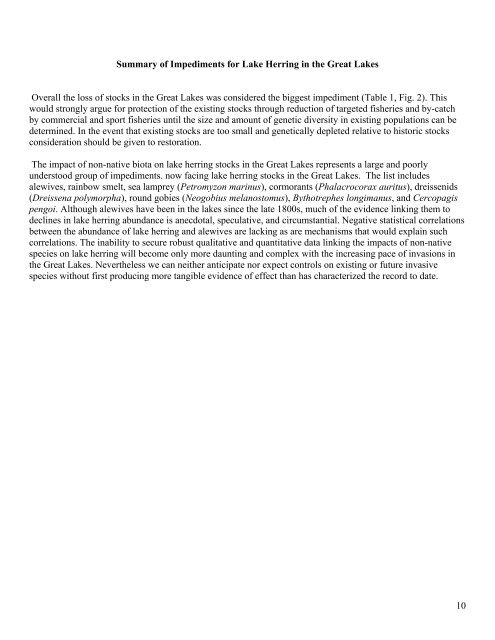Status and assessment, research, and restoration needs for lake ...
Status and assessment, research, and restoration needs for lake ...
Status and assessment, research, and restoration needs for lake ...
Create successful ePaper yourself
Turn your PDF publications into a flip-book with our unique Google optimized e-Paper software.
Summary of Impediments <strong>for</strong> Lake Herring in the Great Lakes<br />
Overall the loss of stocks in the Great Lakes was considered the biggest impediment (Table 1, Fig. 2). This<br />
would strongly argue <strong>for</strong> protection of the existing stocks through reduction of targeted fisheries <strong>and</strong> by-catch<br />
by commercial <strong>and</strong> sport fisheries until the size <strong>and</strong> amount of genetic diversity in existing populations can be<br />
determined. In the event that existing stocks are too small <strong>and</strong> genetically depleted relative to historic stocks<br />
consideration should be given to <strong>restoration</strong>.<br />
The impact of non-native biota on <strong>lake</strong> herring stocks in the Great Lakes represents a large <strong>and</strong> poorly<br />
understood group of impediments. now facing <strong>lake</strong> herring stocks in the Great Lakes. The list includes<br />
alewives, rainbow smelt, sea lamprey (Petromyzon marinus), cormorants (Phalacrocorax auritus), dreissenids<br />
(Dreissena polymorpha), round gobies (Neogobius melanostomus), Bythotrephes longimanus, <strong>and</strong> Cercopagis<br />
pengoi. Although alewives have been in the <strong>lake</strong>s since the late 1800s, much of the evidence linking them to<br />
declines in <strong>lake</strong> herring abundance is anecdotal, speculative, <strong>and</strong> circumstantial. Negative statistical correlations<br />
between the abundance of <strong>lake</strong> herring <strong>and</strong> alewives are lacking as are mechanisms that would explain such<br />
correlations. The inability to secure robust qualitative <strong>and</strong> quantitative data linking the impacts of non-native<br />
species on <strong>lake</strong> herring will become only more daunting <strong>and</strong> complex with the increasing pace of invasions in<br />
the Great Lakes. Nevertheless we can neither anticipate nor expect controls on existing or future invasive<br />
species without first producing more tangible evidence of effect than has characterized the record to date.<br />
10
















